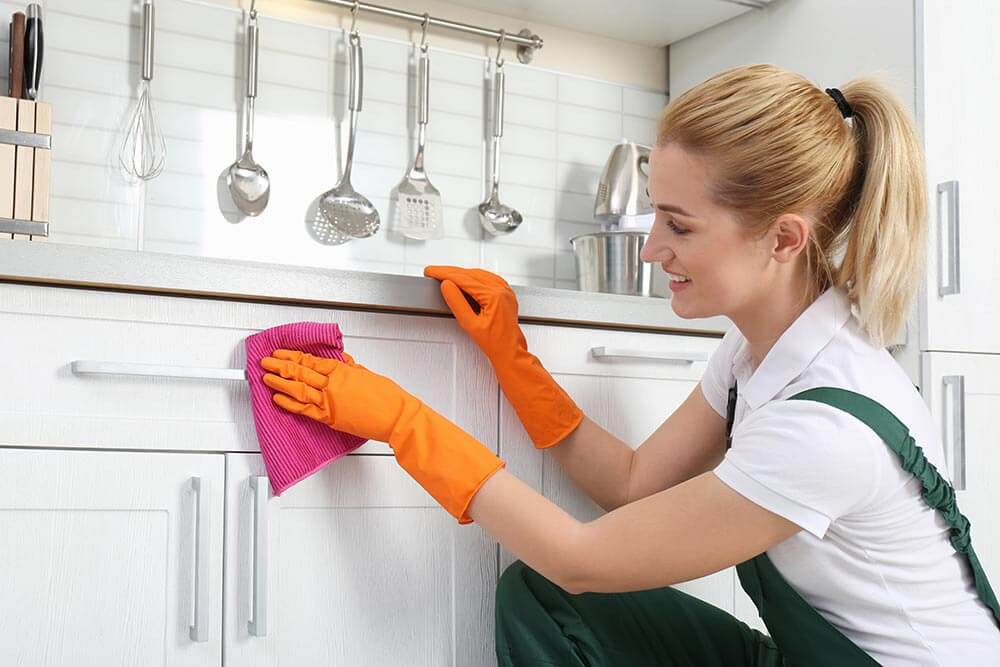How to Clean Kitchen Cabinets

Kitchen cabinets can be subjected to abuse, including spills, splatters, and a constant assault of fingerprints. However, those industrious uppers and lowers often get short shrift during routine weekly cleaning. Grease, dirt, grime, and stains may have piled up significantly by the time you realize they’ve been neglected.
This isn’t just unattractive: it’s also dangerous. Food crumbs hidden in rear corners can attract pests and vermin, and frequently used cabinet hardware can harbor germs. Furthermore, most kitchen cabinets are composed of wood, which is a porous material that can become persistently sticky yet requires a gentler touch than metal or laminate.
Follow our step-by-step cleaning guide to make your kitchen cabinets smell fresh, look stunning, and get them into pristine condition.
1. Empty Everything Out
Begin with the uppermost cabinets and methodically empty the contents so that everything can be returned to its proper place. If you don’t have a lot of counter space to stack stuff on, cleaning kitchen cabinets two or three at a time may be easier, but always start at the top and work your way down.
Once the cabinets are empty, peel off and discard past-its-prime shelf paper if required. You can also clean the shelves and drawers with a vacuum or a damp cloth to remove crumbs and dust.
2. Tackle the Tops
Unless your cabinets are flat with the ceiling, the worst kitchen filth tends to collect at the very top of the wall unit. You can go at it on a ladder or a steep step stool. If it’s just dust, use a long-handled duster or a vacuum’s little round brush attachment to get rid of it.
For combing dirt, Squirt some plain white vinegar over the surface, sprinkle some baking soda on top and let it sit for a few minutes. Scrub with a sponge, then scrape off the filth with a firm straight edge, wiping it away with a rag or paper towels.
Finally, re-spray lightly and wipe dry with a clean cloth.
3. Make a Gentle Cleanser
A few squirts of mild dish soap in hot water is a safe and effective mixture to use on painted and varnished wood (as well as vinyl, metal, and laminate). It will remove grime, smudges, and moderate grease buildup. Add some white vinegar, which has antibacterial qualities, to give the solution a sanitizing boost.
Mix in a spray bottle and apply onto a microfiber cloth or sponge instead of spraying directly on the cabinet surface.
HomePlus keeps outstanding cleaning solutions with fewer chemicals added and that are eco-friendlier. This is one of the top reasons our house cleaning service in Boston receives excellent reviews!
4. Clean from Top to Low
Begin from the top and work your way down. Start with the interiors: the back wall, then the sides, and finally the drawers and shelves. Give special attention to the corner. Spritz the cleaning solution on a toothbrush and scrub gently if necessary.
To remove any soap residue, dampen a cloth or sponge with plain water. Wipe the cabinet dry after rinsing, and then close them.
Clean the sides of the boxes first, and then proceed to the doors and drawer fronts.
5. Attack the Grease
A mild abrasive paste of baking soda and water in a 2:1 ratio is a natural, cost-effective weapon against sticky, yellowish grease buildup.
Apply to stuck-on grease, let it soak in for a few minutes, then scrub gently with a soft-bristled brush (no scraping!) After rinsing, dry with a damp rag, sponge, or microfiber cloth.
If you’re using a commercial product to remove grease, make sure you do a spot test first in an inconspicuous area. Magic erasers, which are made of non-toxic melamine foam and have the texture of super-fine sandpaper, may scratch varnished wood and glossy paint surfaces.
6. Don’t Forget the Cabinet Hardware and Hinges
Wrap a dry towel over your index finger and wipe the hinges. If you come across tenacious grease, use an old soft toothbrush and a 50/50 water-white vinegar mixture to scrub it off, then dry.
Use a toothbrush to clean metal or ceramic hardware, as well as the regions surrounding handles, knobs, and pulls that can collect dirt and grease.
7. Get the Glass Glowing
You can wipe any glass or mirrored panels in your cabinets using a glass cleaner or a mixture of white vinegar and water on a cloth or paper towel. Spraying directly on the glass can cause damage or discoloration because the liquid might soak into the framework joints, producing damage or discoloration. Use a microfiber cloth to make the glass shine.
8. Take Care of the Trim
Grease and grime love cracks, so they’ll find their way into cabinet trim—the more intricate it is, the cruddier it will be.
Gently purge with a soft toothbrush or a cloth wrapped around your index finger and a basic cleaning solution. Rinse and dry with a clean cloth dampened with plain water.
9. Organize the Material
Inspect the cookware, plates, food packages, and other objects before restocking shelves and drawers to ensure they aren’t dusty or soiled. A wipe with a microfiber cloth will ensure that cabinets are returned to a spotless condition.
Cleaning your kitchen cabinets will get easier and faster the more you do it. Aim to wipe off cabinet fronts with a damp cloth a week or so, but if you notice a spill or splash, deal with it right away. We recommend getting a comprehensive deep clean at least once or twice a week. That’s where HomePlus can help!
Our experienced, trained cleaners have top-quality products and equipment at their disposal to leave your cabinets spot-free. Our house cleaning services in Boston receive excellent reviews for performing thorough cleaning procedures.
For booking, press here!
